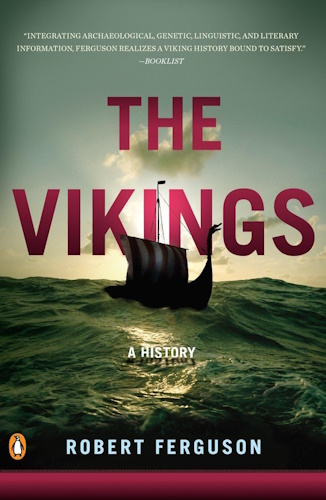

A comprehensive and thrilling history of the Vikings for fans of the History Channel series, soon to return for its fifth season
From Harald Bluetooth to Cnut the Great, the feared seamen and plunderers of the Viking Age ruled Norway, Sweden, and Denmark but roamed as far as Byzantium, Greenland, and America. Raiders and traders, settlers and craftsmen, the medieval Scandinavians who have become familiar to history as Vikings never lose their capacity to fascinate, from their ingeniously designed longboats to their stormy pantheon of Viking gods and goddesses, ruled by Odin in Valhalla. Robert Ferguson is a sure guide across what he calls "the treacherous marches which divide legend from fact in Viking Age history." His long familiarity with the literary culture of Scandinavia with its skaldic poetry is combined with the latest archaeological discoveries to reveal a sweeping picture of the Norsemen, one of history's most amazing civilizations.
Impeccably researched and filled with compelling accounts and analyses of legendary Viking warriors and Norse mythology, The Vikings is an indispensable guide to medieval Scandinavia and is a wonderful companion to the History Channel series.
"Integrating archaeological, genetic, linguistic, and literary information, Ferguson realizes a Viking history bound to satisfy." -Booklist
About the Author
Robert Ferguson began his literary career as a radio dramatist, translating and adapting for radio works by Knut Hamsun and Henrik Ibsen for the BBC. His first literary biography was Enigma: The Life of Knut Hamsun, which was nominated for the Los Angeles Times Best Biography Award. As well as literary biographies, Ferguson has written two novels, published in Norwegian.
Paperback: 464 pages
Publisher: Penguin Books; International Edition edition (September 28, 2010)
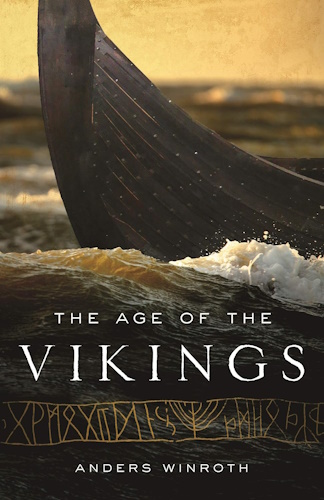

The Vikings maintain their grip on our imagination, but their image is too often distorted by myth. It is true that they pillaged, looted, and enslaved. But they also settled peacefully and traveled far from their homelands in swift and sturdy ships to explore. The Age of the Vikings tells the full story of this exciting period in history. Drawing on a wealth of written, visual, and archaeological evidence, Anders Winroth captures the innovation and pure daring of the Vikings without glossing over their destructive heritage. He not only explains the Viking attacks, but also looks at Viking endeavors in commerce, politics, discovery, and colonization, and reveals how Viking arts, literature, and religious thought evolved in ways unequaled in the rest of Europe. The Age of the Vikings sheds new light on the complex society, culture, and legacy of these legendary seafarers.
Paperback: 320 pages
Publisher: Princeton University Press; Reprint edition (March 1, 2016)
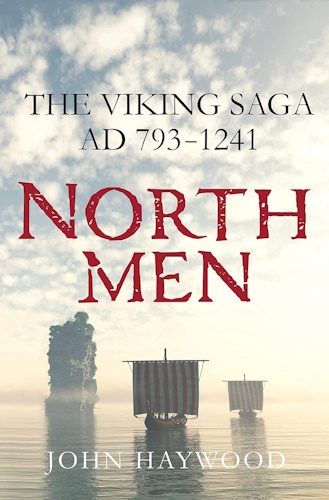

Northmen: The Viking Saga AD 793-1241

From Finland to Newfoundland and Jelling to Jerusalem, follow in the wake of the Vikings―a transformative story of a people that begins with paganism and ends in Christendom.
In AD 800, the Scandinavians were just barbarians in longships. Though they held sway in the north, their power meant little more than the ability to pillage and plunder, which they did to bolster their status at home. But as these Norse warriors left their strongholds to trade, raid, and settle across wide areas of Europe, Asia, and the North Atlantic, their violent and predatory culture left a unique imprint on medieval history. The twist that no one predicted, however, was a much slower, insidious takeover than any the Vikings would execute, and by a turn of the tide, they themselves became its target. For as they made their mark on Europe, Europe made its mark on them. By the year 1200, what remained of the Vikings’ pagan origins floated beneath the surface and the strong, strange territories of the north had become a part of Latin Christendom.
Northmen is there to tell the tale, to pay homage to what was lost and celebrate what was won. Focusing on key events, including the sack of Lindisfarne in 793 and the Battle of Stamford Bridge in 1066, medieval history expert John Haywood recounts the saga of the Viking Age, from the creation of the world through to the dwindling years of halfhearted raids and elegiac storytelling in the thirteenth century. He does so with meticulous research, engaging narrative, and sensitivity for his subject, shedding light and blood along the way.
About the Author
DR. JOHN HAYWOOD is a Cambridge-educated expert on the history of Dark Age Europe. He is also the author ofThe New Atlas of World History, The Penguin Atlas of the Vikings, and Great Migrations
Hardcover: 400 pages
Publisher: Thomas Dunne Books (September 27, 2016)
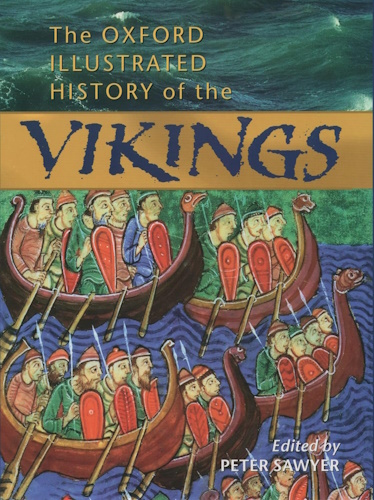

The Oxford Illustrated History of the Vikings

With settlements stretching across a vast expanse and with legends of their exploits extending even farther, the Vikings were the most far-flung and feared people of their time. Yet the archaeological and historical records are so scant that the true nature of Viking civilization remains shrouded in mystery.
In this richly illustrated volume, twelve leading scholars draw on the latest research and archaeological evidence to provide the clearest picture yet of this fabled people. Painting a fascinating portrait of the influences that the "Northmen" had on foreign lands, the contributors trace Viking excursions to the British Islands, Russia, Greenland, and the northern tip of Newfoundland, which the Vikings called "Vinlund." We meet the great Viking kings: from King Godfred, King of the Danes, who led campaigns against Charlemagne in Saxony, to King Harald Bluetooth, the first of the Christian rulers, who helped unify Scandinavia and introduced a modern infrastructure of bridges and roads. The volume also looks at the day-to-day social life of the Vikings, describing their almost religious reverence for boats and boat-building, and their deep bond with the sea that is still visible in the etymology of such English words as "anchor," "boat," "rudder," and "fishing," all of which can be traced back to Old Norse roots. But perhaps most importantly, the book goes a long way towards answering the age-old question of who these intriguing people were.
From sagas to shipbuilding, from funeral rites to the fur trade, this superb volume is an indispensable guide to the Viking world.
About the Author
Peter Sawyer is Emeritus Professor of Medieval History at the University of Leeds.
Series: Oxford Illustrated History
Paperback: 320 pages
Publisher: Oxford University Press; ILL edition (September 20, 2001)
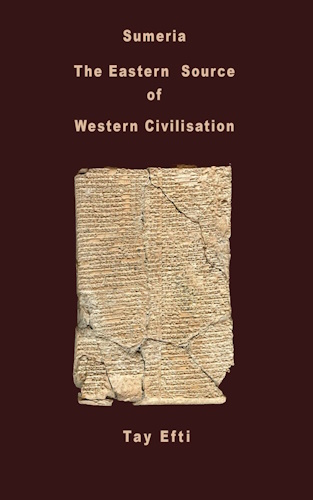

Sumeria:The Eastern Source of Western Civilisation

Who were the Sumerians, where did they come from, in which language did they write and speak in Mesopotamia? Why is it that the city of Ur mentioned in the bible and from where Abraham came, was in fact pronounced like Rome and Abraham himself was a Sumerian of many generations, mistakenly believed to come from Semite origins? These questions form the basis of a fascinating and stimulating analysis by Tay Efti. In his book he refers to previous research in the study of Sumeria and the latest genetic research as well as an analysis of the available linguistic material in the field of Sumerology. His challenging discoveries have significant implications and call for a re examination of the origins of Western Culture and indeed the cultural origins of humanity as a whole. The core assertions and values of European civilisations are most probably based on the achievements of Sumerians and Etruscans who themselves are related ethnically and through language. After defeat at the hands of pagan tribes, the Sumerians migrated to various lands to the south, to Europe and Asia bringing with them their knowledge and beliefs and disseminating their culture and thought throughout the known world. Tay Efti maintains that the Sumerians did not disappear but moved to new lands and adapted their culture and knowledge to new circumstances, sustaining and transmitting their values into new environments which can be proved to form the basis of Western culture and civilisation.
Paperback: 226 pages
Publisher: CreateSpace Independent Publishing Platform (February 18, 2016)
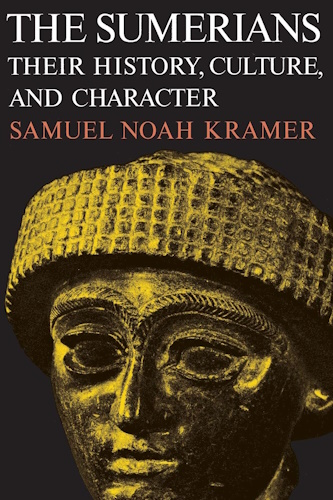

The Sumerians: Their History, Culture, and Character

The Sumerians, the pragmatic and gifted people who preceded the Semites in the land first known as Sumer and later as Babylonia, created what was probably the first high civilization in the history of man, spanning the fifth to the second millenniums B.C. This book is an unparalleled compendium of what is known about them.
Professor Kramer communicates his enthusiasm for his subject as he outlines the history of the Sumerian civilization and describes their cities, religion, literature, education, scientific achievements, social structure, and psychology. Finally, he considers the legacy of Sumer to the ancient and modern world.
"There are few scholars in the world qualified to write such a book, and certainly Kramer is one of them. . . . One of the most valuable features of this book is the quantity of texts and fragments which are published for the first time in a form available to the general reader. For the layman the book provides a readable and up-to-date introduction to a most fascinating culture. For the specialist it presents a synthesis with which he may not agree but from which he will nonetheless derive stimulation."—American Journal of Archaeology
"An uncontested authority on the civilization of Sumer, Professor Kramer writes with grace and urbanity."—Library Journal
Paperback: 372 pages
Publisher: University of Chicago Press; Revised ed. edition (February 15, 1971)
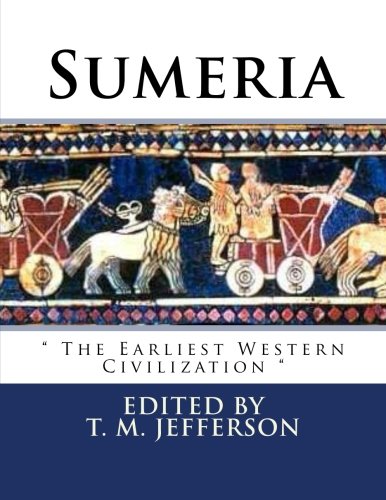

Sumeria: The Earliest Western Civilization

Sumer was the first ancient urban civilization in the historical region of southern Mesopotamia, modern-day southern Iraq, during the Chalcolithic and Early Bronze ages, and arguably the first civilization in the world. Proto-writing in the region dates back to c. 3500 BC. The earliest texts come from the cities of Uruk and Jemdet Nasr and date back to 3300 BC; early cuneiform writing emerged in 3000 BC. Modern historians have suggested that Sumer was first permanently settled between c. 5500 and 4000 BC by a West Asian people who spoke the Sumerian language (pointing to the names of cities, rivers, basic occupations, etc., as evidence), a language isolate. These conjectured, prehistoric people are now called "proto-Euphrateans" or "Ubaidians", and are theorized to have evolved from the Samarra culture of northern Mesopotamia (Assyria). The Ubaidians (though never mentioned by the Sumerians themselves) are assumed by modern-day scholars to have been the first civilizing force in Sumer, draining the marshes for agriculture, developing trade, and establishing industries, including weaving, leatherwork, metalwork, masonry, and pottery. However, some scholars contest the idea of a Proto-Euphratean language or one substrate language. It has been suggested by them and others, that the Sumerian language was originally that of the hunter and fisher peoples, who lived in the marshland and theEastern Arabia littoral region, and were part of the Arabian bifacial culture. Reliable historical records begin much later; there are none in Sumer of any kind that have been dated before Enmebaragesi (c. 26th century BC). Professor Juris Zarins believes the Sumerians were settled along the coast of Eastern Arabia, today's Persian Gulf region, before it flooded at the end of the Ice Age. Sumerian civilization took form in the Uruk period (4th millennium BC), continuing into the Jemdat Nasr and Early Dynastic periods. During the 3rd millennium BC, a close cultural symbiosis developed between the Sumerians, who spoke a language isolate, andAkkadian-speakers, which included widespread bilingualism. The Sumerian culture seems to have appeared as a fully formed civilization, with no pre-history. This book present a thorough history and background of the Sumerian civilization. This book is designed to be an overview of the topic and provide you with the structured knowledge to familiarize yourself with the topic at the most affordable price possible. The level of discussion is designed to be a more in-depth discussion than books such as “Computers for Dummies” but less technical than “The IEEE standards for the Core 2 Duo processor of the Intel Centrino chipset.” The accuracy and knowledge is of an international viewpoint as the edited articles represent the inputs of many knowledgeable individuals and some of the most currently available general knowledge on the topic based on the date of publication.
About the Author
The author has traveled extensively around the world studying world religions, cultural mythology and cultural anthropology. He has degrees from the University of Michigan and has worked in the corridors of power in Washington, DC and has informally studied the influence of belief systems on politics.
Paperback: 212 pages
Publisher: CreateSpace Independent Publishing Platform; 1st Edition edition (May 30, 2016)
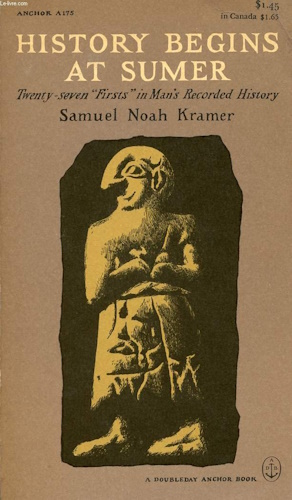

The very beginnings of man's history are recorded in the strange wedge-shaped marks inscribed upon the tablets of Sumer. Unearthed about at century ago from the mounds in Mesopotamia where they had lain for more than three thousand years, and deciphered only after decades of painstaking work, the tablets tell the story of civilization long forgotten, where culture as we know it was born. In this book, which won an award as the best foreign book of the year when it was published in France in 1957, Dr. Samuel Noah Kramer, America's foremost Sumerologist, describes twenty-seven "firsts" in human history and in this way constructs and intimate and vivid picture of everyday public and private life five thousand years ago.
Paperback: 247 pages
Publisher: Doubleday (1959)
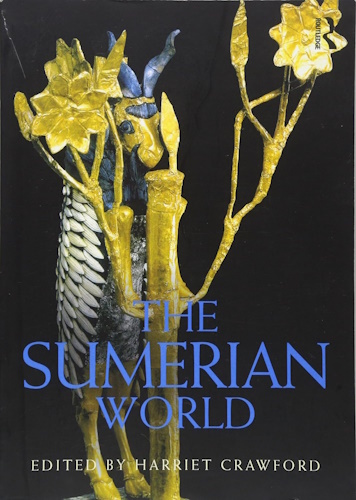

The Sumerian World explores the archaeology, history and art of southern Mesopotamia and its relationships with its neighbours from c.3,000 - 2,000BC. Including material hitherto unpublished from recent excavations, the articles are organised thematically using evidence from archaeology, texts and the natural sciences. This broad treatment makes the volume of interest to students looking for comparative data in allied subjects such as ancient literature and early religions.
About the Author
Harriet Crawford is Reader Emerita at UCL’s Institute of Archaeology and a senior fellow at the McDonald Institute, Cambridge. She is a specialist in the archaeology of the Sumerians and has worked widely in Iraq and the Gulf. She is the author of Sumer and the Sumerians (second edition, 2004).
Series: Routledge Worlds
Paperback: 684 pages
Publisher: Routledge; 1 edition (October 5, 2016)
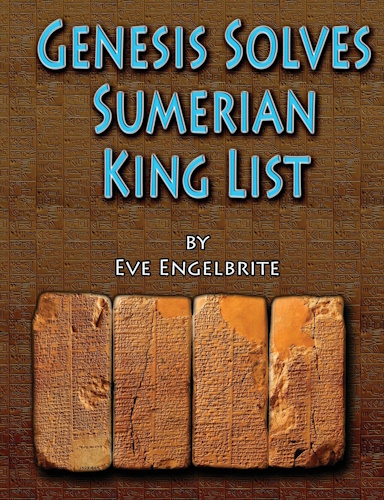

Genesis Solves Sumerian King List

Genesis Solves Sumerian King List synchronizes the kings and clues of the Sumerian King List with ancient Biblical history. The oldest and most complete copy of the Sumerian King List (SKL) is an engraved clay rectangular prism. It has a reference to the Biblical flood; “After the flood had swept over, and the kingship had descended from heaven, the kingship was in Kish.” The antediluvian kings had much longer reigns than those after the flood in the list, corresponding to the lifespans recorded in Genesis. This book deciphers the reigns of post-flood kings in a way which equals the SKL subtotals; a feat not accomplished until now! This book links Cush of Ur to the SKL's Gishur, and Cush's son Nimrod to the SKL's Enmerkar. Their tyrannical reign is known as the Uruk Expansion, the end of which I place at the Tower of Babel during the Ice Age which Job described in the Bible. With 30 pictures and over 70 charts, Genesis Solves Sumerian King List is simple enough for the novice to follow, yet robust with over 500 footnotes for the scholar.
Paperback: 216 pages
Publisher: Inspired Idea; 1 edition (March 10, 2016)
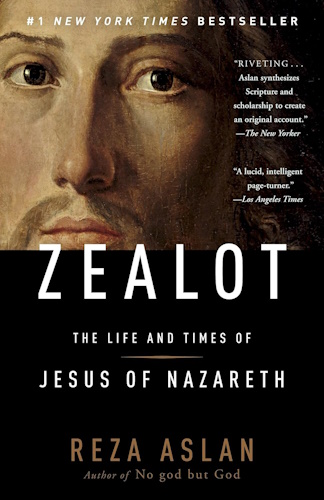

Zealot: The Life and Times of Jesus of Nazareth

#1 NEW YORK TIMES BESTSELLER • “A lucid, intelligent page-turner” (Los Angeles Times) that challenges long-held assumptions about Jesus, from the host of Believer
Two thousand years ago, an itinerant Jewish preacher walked across the Galilee, gathering followers to establish what he called the “Kingdom of God.” The revolutionary movement he launched was so threatening to the established order that he was executed as a state criminal. Within decades after his death, his followers would call him God.
Sifting through centuries of mythmaking, Reza Aslan sheds new light on one of history’s most enigmatic figures by examining Jesus through the lens of the tumultuous era in which he lived. Balancing the Jesus of the Gospels against the historical sources, Aslan describes a man full of conviction and passion, yet rife with contradiction. He explores the reasons the early Christian church preferred to promulgate an image of Jesus as a peaceful spiritual teacher rather than a politically conscious revolutionary. And he grapples with the riddle of how Jesus understood himself, the mystery that is at the heart of all subsequent claims about his divinity.
Zealot yields a fresh perspective on one of the greatest stories ever told even as it affirms the radical and transformative nature of Jesus’ life and mission.
About the Author
Reza Aslan is an acclaimed writer and scholar of religions whose books include No god but God: The Origins, Evolution, and Future of Islam and Zealot: The Life and Times of Jesus of Nazareth. He is also the author of How to Win a Cosmic War: God, Globalization, and the End of the War on Terror (published in paperback as Beyond Fundamentalism), as well as the editor of Tablet & Pen: Literary Landscapes from the Modern Middle East. He lives in Los Angeles with his wife and three sons.
Paperback: 336 pages
Publisher: Random House Trade Paperbacks; Reprint edition (September 9, 2014)
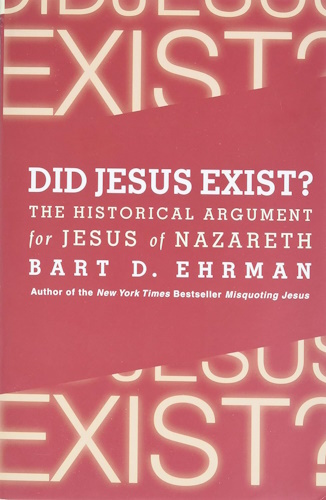

Did Jesus Exist?: The Historical Argument for Jesus of Nazareth

In Did Jesus Exist? historian and Bible expert Bart Ehrman confronts the question, "Did Jesus exist at all?" Ehrman vigorously defends the historical Jesus, identifies the most historically reliable sources for best understanding Jesus’ mission and message, and offers a compelling portrait of the person at the heart of the Christian tradition.
Known as a master explainer with deep knowledge of the field, Bart Ehrman methodically demolishes both the scholarly and popular “mythicist” arguments against the existence of Jesus. Marshaling evidence from within the Bible and the wider historical record of the ancient world, Ehrman tackles the key issues that surround the mythologies associated with Jesus and the early Christian movement.
In Did Jesus Exist?: The Historical Argument for Jesus of Nazareth, Ehrman establishes the criterion for any genuine historical investigation and provides a robust defense of the methods required to discover the Jesus of history.
Paperback: 368 pages
Publisher: HarperOne (March 19, 2013)


The Quest of the Historical Jesus

In this groundbreaking work that made his reputation as a theologian, Albert Schweitzer traces the search for the historical person of Jesus (apart from the Christ of faith) and puts forward his own view of Jesus as an apocalyptic figure who preached a radical message of the coming of the Kingdom of God. Though Schweitzer's own proposals about Jesus no longer command assent, his lasting contribution, comprising the bulk of the book, is the critique of his predecessors. Through examining the works of more than 50 18th- and 19th-century authors and scholars, he shows conclusively that each historical reconstruction of Jesus was largely a fantasy made in their own self-image.
Schweitzer's work has proved the touchstone for all subsequent quests for the "Jesus of history." It also contributed in no small measure to the remarkable resurgence in Jesus studies in the latter part of the 20th century, which culminated in the much publicized and highly controversial findings of the Jesus Seminar.
Paperback: 416 pages
Publisher: Dover Publications; Dover Ed edition (February 11, 2005)
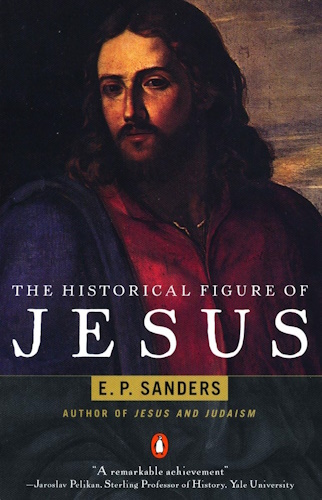

The Historical Figure of Jesus

A biography of the historical figure of Jesus. The book studies the relationship between Judaism and Christianity, distinguishing the certain from the improbable, and assessing the historical and religious context of Christ's time. The spread of Christianity is also discussed.
About the Author
Ed Sanders was a Professor of Religion at Duke University until 2005. His other works include Paul and Jesus and Judaism.
Paperback: 337 pages
Publisher: Penguin Books; Reprint edition (January 1, 1996)
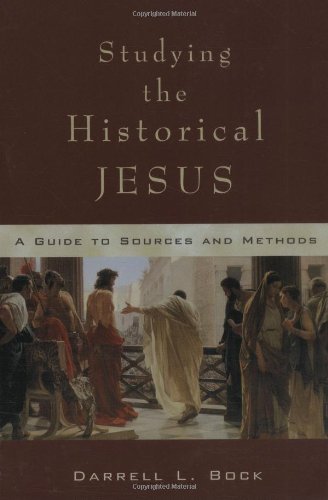

Studying the Historical Jesus: A Guide to Sources and Methods

Interest in the historical Jesus continues to occupy much of today's discussion of the Bible. The vexing question is how the Jesus presented in the Gospels relates to the Jesus that actually walked this earth.
Studying the Historical Jesus is an introductory guide to how one might go about answering that question by doing historical inquiry into the material found in the Gospels. Darrell Bock introduces the sources of our knowledge about Jesus, both biblical and extra-biblical. He then surveys the history and culture of the world of Jesus. The final chapters introduce some of the methods used to study the Gospels, including historical, redaction, and narrative criticisms.
Bock, a well respected author, provides an informed evangelical alternative to radical projects like the Jesus Seminar. His audience, however, is not limited only to evangelicals. This book, written for college and seminary courses, offers an informed scholarly approach that takes the Gospels seriously as a source of historical information.
About the Author
Darrell L. Bock (Ph.D., University of Aberdeen) is Research Professor in New Testament Studies at Dallas Theological Seminary. He is the author or editor of more than ten books, including the two-volume BECNT commentary on Luke.
Paperback: 232 pages
Publisher: Baker Academic (July 1, 2002)
![]()
![]()